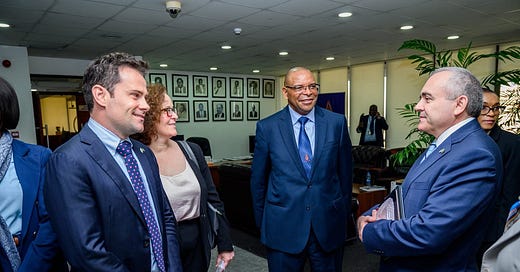Zambia Secures IMF Lifeline, But Sovereign Fortitude Still on Trial
$194M Disbursement Buoys Reserves as Zambia Grapples with Fiscal Slippage and Reform Fatigue
The IMF agreement marks an important step in reducing immediate sovereign risk through a stronger financial position and a clear reform agenda. However, lingering fiscal deficits, debt sustainability threats, and the pace of essential reforms remain pivotal. Careful execution of the revised budget, revenue enhancement, and governance reforms will determine whether Zambia’s sovereign risk continues to recede or reverts to vulnerable territory.
Africa’s second largest copper hotspot Zambia, has clinched a pivotal agreement with the International Monetary Fund (IMF), unlocking the likelihood a fresh $194 million disbursement under its Extended Credit Facility (ECF). The deal, which comes amid recovering growth and fragile fiscal metrics, marks a critical checkpoint in the nation’s post-default stabilisation plan. While investors may breathe a temporary sigh of relief, Zambia’s sovereign risk profile remains delicately balanced, tied to reform execution, fiscal discipline, and external debt dynamics. The IMF and Zambia’s MinFin reached a staff‑level agreement to conclude the fifth review of the 38‑month ECF arrangement. Upon IMF Executive Board approval, this milestone would trigger a disbursement of SDR 139.9 million ($194 million) bringing cumulative disbursements under the facility to approximately $1 billion.
Read: Zambia Courts IMF Confidence as Reform Crossroads Near
The agreement underscores the Fund’s continued confidence in Zambia’s reform path, though conditionalities remain firmly anchored around fiscal realignment, structural governance improvements, and external debt sustainability.
Resilience on Track - Growth & Buffers Solidify
Zambia’s economy is showing early signs of recovery with its 2024 gross domestic product growth rebounding to 4.0%, well above previous estimates of 1.2%, fuelled by strong performance in mining, information communication and technology, construction, and a less severe agricultural contraction than initially feared. The 2025 growth outlook has been upgraded to 5.8%, anchored by expectations of an agricultural rebound, stronger copper production, and stabilised power supply. This compares with a 6.2% forecast by its ministry of finance earlier in the year, a trim from the 6.6% budget projection. External metrics have improved evidenced by a current account deficit narrowing while foreign exchange reserves buoyed to US$4.7 billion —equivalent to 4.6 months of import cover. This signals improving macroeconomic resilience, although the gains remain vulnerable to commodity shocks and weather volatility.
Inflation Moderating, But Fiscal Deficit Widening
Inflation averaged around 15% in 2024, peaking at 16.8% in early 2025. In response, the Bank of Zambia hiked its policy rate to 14.5% in its first rate decision meeting of the year, helping to curb inflation momentum. Recent readings show a modest downward trend in consumer prices as food prices are aggressively ebbing.
Yet fiscal slippage looms, the overall fiscal deficit is projected at 5.3% of GDP in 2025, up from earlier targets while Zambia still aims for a primary balance of 1.1% of GDP, indicating some underlying fiscal restraint, the IMF note carried. To meet these goals, authorities will revise the 2025 budget, scale back non-essential spending, and deploy new revenue-enhancing measures. However, the path to consolidation remains politically and technically fragile.
Structural Reforms: Promise vs. Delivery Risk
The IMF has placed considerable emphasis on structural reform momentum, including the following:
Broadening the tax base and modernising revenue collection.
Tightening expenditure controls and improving fiscal transparency.
Advancing state-owned enterprise (SOE) reform and public procurement transparency.
Liberalising the energy and fuel pricing framework, aiming to phase out unsustainable subsidies.
Execution remains the key risk. Past reform cycles in Zambia have suffered from reversals and inconsistent implementation, raising red flags for investors evaluating sovereign sustainability.
Sovereign Risk Posture: A Two-Speed Narrative
✅ Near-Term Gains
The IMF review and upcoming disbursement materially improve Zambia’s external liquidity. With $194 million incoming and higher reserves, short-term sovereign liquidity stress is alleviated. Investors may interpret this as a near-term credit stabiliser, especially for Eurobond holders and official creditors.
⚠️ Medium-Term Fragility
However, structural fiscal weaknesses and high debt-service costs continue to weigh on Zambia’s sovereign profile. Any delay in budget reform, external debt restructuring, or tax mobilisation could reignite pressure on the Kwacha, drive up local yields, and widen credit spreads.
🔄 Reforms as Risk Catalysts
IMF program traction will act as a forward-looking gauge of sovereign credibility. Structural reform delays, especially in energy and SOE sectors, could reprice Zambia’s risk premium, especially in frontier debt markets.
🌍 External Sensitivities
Zambia remains highly exposed to global copper prices, foreign investor sentiment, and climate related shocks. While commodity tailwinds could support growth, a downturn would quickly test the robustness of current buffers.
Conclusion: Reform or Reversion?
Zambia has taken a meaningful step forward in its post default rehabilitation. But the road ahead is narrow and lined with fiscal, political, and market hazards. For now, the IMF’s endorsement buys time, credibility, and some liquidity. Yet the country’s sovereign fortitude will be judged not by agreements signed but by reforms delivered.
Zambia’s IMF ECF expires on 31 October this year which lingers thoughts around whether the red metal producer will engage the Washington based lender for renewal post in view of sovereign dynamics such as elections in under a years’ time. A non-renewal could expose the restructured dollar bonds to credit risks though sped blow outs that could impact debt service costs. On the upside Zambia’s political leadership has demonstrated the will power to restore fiscal fitness to this stage, continuity remains critical for preservation of all gains amassed to this point.





